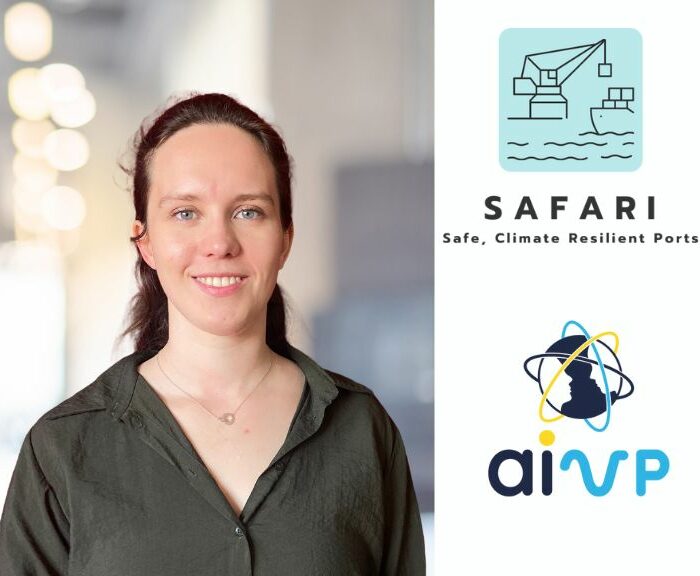The port of Sète, created in 1666 under the reign of Louis XIV, is now the second largest port on the Mediterranean coast after Marseille-Fos. It is a multi-purpose port, an essential link in the logistics chain of the Occitanie region, and a gateway to Europe. It is owned by the Occitanie / Pyrénées-Méditerranée region, which in 2008 set up a regional public institution called “Port Sud de France” to manage the 3 port concessions: the commercial, fishing and yachting ports. The port of Sète – Frontignan plays a key role as an economic player, supporting the fishing industry, whose trawler activity is in difficulty, promoting international trade, hosting industrial activities, supporting tourism and generating numerous direct and indirect jobs.
The city of Sète lies on a lido between the Etang de Thau, a lagoon ecosystem, and the Gulf of Lion. It backs onto Mont-Saint-Clair, an escarpment that constitutes a remarkable natural heritage. Geographical constraints are also the strength of Sète, which has based its identity on its maritime, coastal and port history. Today, it is the most populous commune in a conurbation that also includes Frontignan, Mèze and Marseillan.
The dynamic growth of the Port of Sète since at least 2019 has been much noted. The various types of traffic, particularly ferries and cruise ships, represent both an economic opportunity and a challenge for the balance of the region. Sète’s marina is also very active, with 800 berths and a thousand additional moorings along the canals.
The local players have succeeded in establishing a new dynamic of cooperation. Various projects have emerged to green the port and redevelop the city-port interface. That’s why we wanted to interview François Commeinhes, Mayor of Sète, and Philippe Malagola, President of the Port of Sète.
The Port of Sète Sud de France joined AIVP in 2023 and the City of Sète in 2024.
Could you tell us how you manage to harmoniously reconcile port development and the living environment?
City of Sète
Sète was built around its port. Whether it’s fishing, trading, cruising or yachting, the town retains a close link with port activity. “When I go back along the chain of my life, I find it attached by these iron rings that are sealed in the stone of our quays. The other end is in my heart”, wrote Paul Valéry. This phrase, now engraved on a monumental sculpture adjacent to the marina, symbolizes the town’s attachment to its port. In 2016, the 350e anniversary of the port’s creation was the occasion for a major heritage, cultural and popular celebration that drew huge crowds, culminating in the “Escale à Sète” event, the largest biennial celebration of Mediterranean maritime traditions co-organized by the eponymous association, the town and the port.
Port development contributes to a dynamic economic life and job creation. The fishing boats moored in the heart of the city are the crucible of its identity. Cruise passengers benefit the shops and restaurants in the town center. Average spending is estimated at 50 euros per person. Walking tours organized by the Sète agglopôle Méditerranée tourist office invite cruise passengers to visit the town center.
The port of Sète is also a question of landscapes, of contemplating the work of men. Historically, port activity has always been intertwined with the town, first with wine and cooperage traffic, then with the fishing port, and finally at the beginning of the 20th century with the diversification of the commercial port. The development of industrial activities then made cohabitation more complex, until the sudden closure of the Frontignan refinery. In the doldrums of the early 2000s, port activity was revived thanks to major investments by the Occitanie region, which concentrated development to the east of the town, less visible from the town center. The destruction of the old grain silos in 2013, which stood 52 m high, also opened up new landscape perspectives.
Port of Sète
Naturally, the town and the port, the port and the town are intertwined. Not only the port’s fish auction, but also all of the marina’s structures have historically been integrated into the city center. More recently, the Grande Plaisance Yachting center has been integrated into the commercial port on the Orsetti basin, and will be completely refurbished in 2019 in order to better integrate the city and the port. The refurbishment involved relocating the ferry arrivals, providing OPS and planting the yachting basin.

The development of the Port of Sète-Frontignan reached this year its 9th consecutive year of record activity (excluding covid year), i.e. increasing development since 2014. Thanks to investments by the Occitanie Region, the port’s owner, the Port of Sète has been able to modernize its infrastructure, diversify its activities and become an attractive, dynamic and environmentally-friendly port. Investments reflect a remarkable partnership between the public (Occitanie Region and Port Sud de France) and private (industrialists present in the port) sectors. In 2019, we reached a peak in cruise activity, with 115,000 cruise passengers calling at Sète (compared with 1,866,0000 for Marseille in the same year).
In the wake of the 2020 pandemic, the Port of Sète and the Club des Croisières de Sète, the organization that promotes the destination, reviewed their strategy, opting for the development of reasoned cruising (ships under 240 m) and a target of 70,000 passengers for the 2021-2025 strategic project, compared with the 150,000 initially planned. In 2023, 50 calls and 27,000 passengers were welcomed to the port of Sète. A new tourism offering has also been introduced for cruise passengers, with a catalog of “green” excursions designed to provide a unique, eco-friendly experience for tourists wishing to discover the natural beauty and cultural richness of Sète and the Bassin de Thau, while respecting the environment (electric bike rides, sea kayaking or kayaking on the pond, electric boats… and tourist destinations closer to Sète, thus reducing the need to travel).

Finally, the Port of Sète has decided to anticipate the regulations on decarbonization of its activities, by proposing from 2020 an incentive pricing policy based on the Environmental Ship Index (ESI) to reward the most virtuous ships. At the end of 2023, the Port of Sète took a major step towards decarbonizing its activities, with the delivery of four electrification points on three quays. These electrical connections enable regular ferry and ro-ro lines to reduce CO2 emissions and noise pollution when docked. Cruising connections, requiring more power, are scheduled for 2026.

On the yachting side, the port is unique in that it stretches across the entire center of Sète. Its port facilities can accommodate monohulls and multihulls from 6 to 50 meters. In all, more than 1,800 berths are managed by the regional public institution Port de Sète – Sud de France.

Finally, privileged partnerships with environmental organizations, enable regular awareness-raising campaigns for users and the general public, notably during events such as the Open Port days, which this year take place during the Heritage Days (September 20, 21 and 22, 2024).

(City of Sète) Your sustainable development plan indicates a will to rehabilitate former industrial and port land at the eastern entrance to the city, as well as to create a multimodal hub around the main railway station. All this is located in the immediate vicinity of the port area. This raises questions of mobility and accessibility. What can you tell us about your initiatives to enhance the city-port interface?
The territory of the Greater Sète was marked by a strong period of urbanization in the 1980s to 2000, which resulted in a very high consumption of space. Since the first masterplan was adopted unanimously by the 14 municipalities in 2014, the Thau basin has divided its consumption of new space by 4. Today, the aim is to achieve zero net artificialization by 2050, despite significant land requirements. Industrial and port wastelands offer a real opportunity to meet this challenge. The Greater Sète has been awarded the title of “Territoire pilote de sobriété foncière” (“Pilot territory for land conservation”), and is pursuing a strategy of densifying the Thau arc to avoid urban sprawl, while at the same time meeting part of the economic and housing land requirements that are vital to the region’s development and to satisfying the housing needs of the local population.
One of the first projects of this kind is the development of a new district at the eastern entrance to Sète. Created by reclaiming former industrial and port wastelands, this new district will cover 18 hectares and will be equipped with a thalassothermal system. Attractive, dynamic and innovative, it offers a modern and friendly living environment for working people and young households. Nearly 39,000 m2 will be dedicated to commercial and service activities, mixed with a residential area housing a total of 1,800 homes. This overhaul of the city’s eastern entrance is complemented by a reconfiguration of its access to the heart of the conurbation, in particular the multimodal interchange located less than ¼ hour away on foot. This facility will feature a bus station, a sea-river stopover, bicycle parking and an increased-frequency train link to Montpellier or Narbonne, with the hope of maintaining direct high speed service.
Beyond this district, the reclamation of industrial wasteland also aims to enable the development of the blue economy. With the ambition of becoming the reference territory for blue growth in Occitania, Sète and the Thau Basin have federated key players around a blue growth pact. The port is an integral part of this pact and of this new economic development strategy, which integrates 4 areas of strategic action:
- port-related operational projects, infrastructure and maritime transport,
- projects linked to the region’s fisheries production activities,
- projects related to tourism and coastal development,
- boating and yachting.
Some twenty partners have already signed the pact, including Ifremer, Sathoan, the Pôle Mer, Cépralmar, the Occitanie Region, the French government, the University of Montpellier…
(Port of Sète) Between now and 2025, you intend to invest heavily to become a “smart port”, with two strong pillars: sustainable development and innovation. We know the obstacles that ports face when implementing projects such as the electrification of quays. Dialogue with operators is a complex process, due to the multiplicity of stakeholders in the ecosystem. Could you mention a few of the projects you’ve set up and tell us how you intend to achieve your greening objective?
The port decided to integrate the sustainable development of its activities into its Strategic Plan 2016-2020. We have built the Smart&Green Port strategy around 4 pillars in order to integrate technological and environmental ambitions into our development. First of all, the promotion of low-emission modes of transport, which is one of the strengths of the Port of Sète. We are a multimodal port with 42 km of intra-port rail tracks, and we inaugurated our new rail platform at the end of 2021, after being selected by the State as part of the government’s Recovery Plan focused on the development of rail highways, announced in July 2020 by the Prime Minister Jean Castex. After 2 and a half years in operation, we have transited 15,000 units/year by rail, with a target of 40,000. The port of Sète is also home to the mouth of the Canal du Rhône à Sète, enabling goods to be transported by river as well.
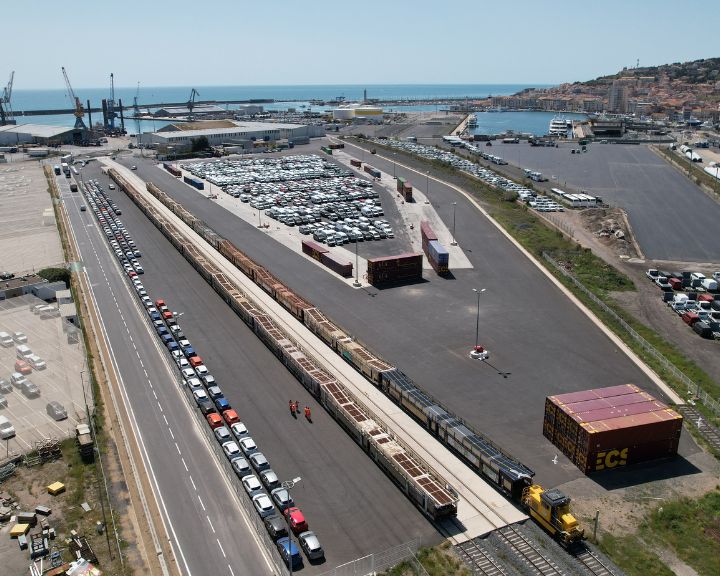
The second pillar aims to develop renewable energies and diversify our energy sources. The Port of Sète was a pioneer in the installation of photovoltaic panels on the roofs of port warehouses. By the end of 2020, the port had more than 4 ha of solar cover, producing 2.5 times the annual consumption of Port Sud de France’s operations across its 3 ports. A second photovoltaic phase is currently under study, with the introduction of a further 10 ha of self-consumption shading.
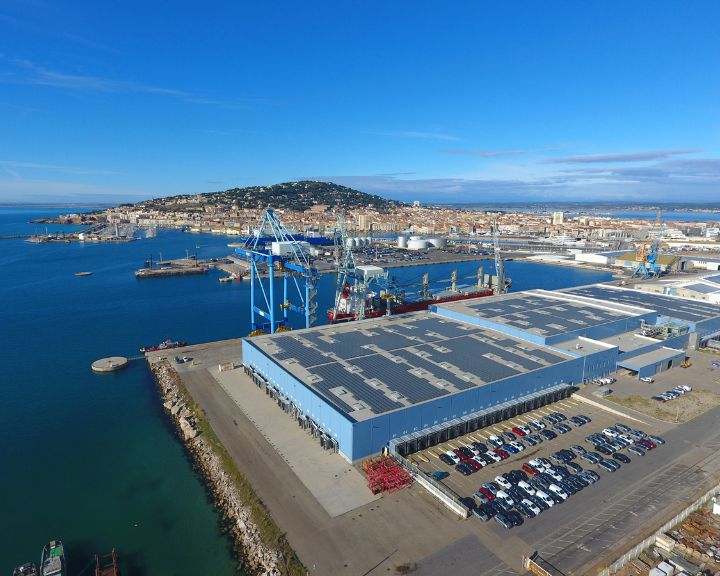
The third pillar of our Smart&Green Port strategy is the implementation of a low-carbon strategy, with various initiatives such as the replacement of the port’s vehicle fleet with an electric one. From 2020 onwards, we will be implementing an incentive pricing policy based on ESI, renewing our port equipment with the latest-generation tools, and of course the project to connect the port’s electricity supply to the quayside, planned in several stages, which will have an immediate and short-term impact on our direct environment. All these actions cannot be implemented without a constant watch on developments and innovative solutions that may emerge. We are active in this watch and dedicate part of our teams to innovation.
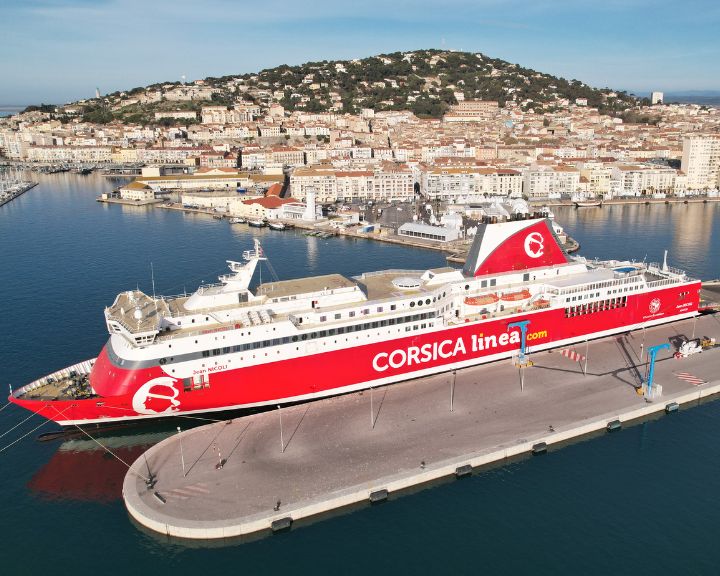
The last pillar concerns environmental management, establishing procedures and practices to reduce our impact in a sustainable way, and quality social dialogue to ensure that all port employees feel involved in the process.
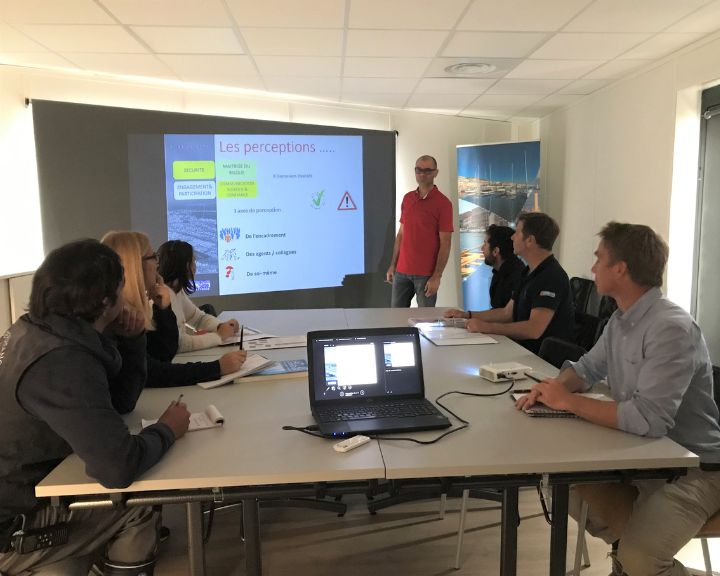
The Thau Lagoon contains a rich biodiversity. It is connected to various rivers and to the nearby Camargue. We know that you pay particular attention to the preservation of this lagoon, which is classified as a Natura 2000 site. How can the port authority cooperate with the municipality, or the agglomeration community, to preserve the environment?
Port of Sète
The gradual development of the town of Sète and its port since 1666 has led to changes in the coastline and exchanges between the sea and the Thau lagoon, increasing pressure on the aquatic environment. This same development has led to the creation of new habitats for different species and life stages, with over 34 km of coastline developed, new hard substrates and the creation of new sheltered stretches of water (700 ha).
That’s why, in 2019, the Port of Sète, committed to protecting the environment, launched a wide-ranging study of its marine biodiversity with the help of the Agence de L’eau. This study has highlighted the various ecological functions (nursery, habitat, connectivity with the Thau Lagoon, reproduction, etc.), both historical and new, by detecting areas at stake and areas under pressure by sector. The study highlighted the importance of pursuing the action plan developed since 2013 to reduce pressures on the aquatic environment, and of carrying out actions to protect biodiversity.
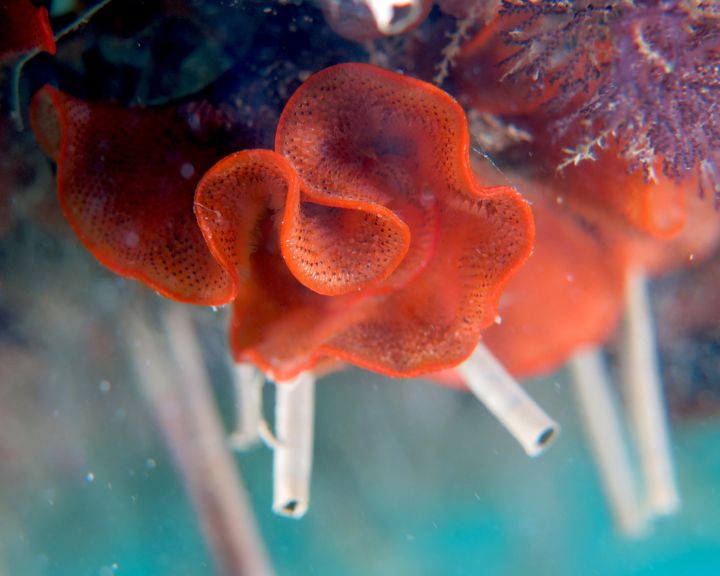
Firstly, the Port de Sète – Sud de France’s Port “Clean Port and Active Port in Biodiversity” strategy has structured an approach to progress based on concrete actions, while providing an internationally recognized benchmark. By way of example, port agents are trained in the importance of these issues as soon as they take up their posts, and receive regular anti-pollution training.
Aware of the direct link with the Thau lagoon, port agents monitor the water daily. Throughout the year, Port Sud de France works to preserve the marine environment, with a cleaning service provider whose mission is to collect liquid waste from ships and floating macro-waste.
In line with the Smart&Green port strategy, the port also relies on innovations to further improve its environmental performance. In 2024, the port tested ‘Dpol’ suction robots and absorbent pads made from recycled goose feathers from used badminton shuttlecocks. In collaboration with its local partners, the port is now considering a bubble barrier system to stop pollution entering or leaving the lagoon.
This approach also relies on the support of the 2,000 yachtsmen in the port of Sète, who are welcomed on arrival with anti-pollution kits and educated each year with the help of the CPIE du Bassin de Thau, which encourages them to adopt and develop eco-actions on a daily basis.
Finally, our partnership with the environmental organizations enables us to communicate to as many people as possible in a fun and educational way about the challenges of plastic pollution facing the lagoon and the Mediterranean Sea.

City of Sète
Bordered to the south by the Mediterranean and to the north by the Thau lagoon, a Natura 2000 site, Sète is a maritime city of character that has always attached particular importance to fishing activities. Fishing and marine cultures are the main vocation of the Thau lagoon, which implies a permanent watch on the surrounding anthropic impacts. As a result, development and water management policies are specific to the Thau basin. These are set out in the coastal section of the water and land master plan, which impose maximum permissible flows per sub-catchment area, the fruit of innovative scientific work involving research institutes and local water authorities.
In order to involve all stakeholders in this policy, and to facilitate dialogue and ownership of the issues at stake, territorial contracts have been set up. Today, the Thau Integrated Management and Ecological Transition Contract 2020-2025 is the 5th generation of Thau contracts. It comprises 59 action sheets for an estimated total of 580 million euros, focusing on 4 main areas:
- Resilient, sustainable development
- A global economy
- Balanced environmental management
- Citizen participation and innovation
The Occitanie Region and the Port of Sète Sud de France are fully involved in drawing up and coordinating these contracts, which are a roadmap for concerted, coordinated public action to enhance the environmental quality of the Thau lagoon.




